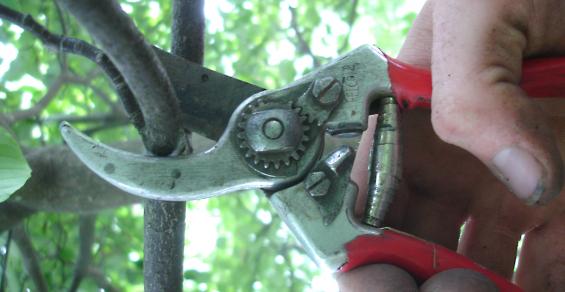There are five types of tree branches that need to be removed before spring.
My favorite winter activity, besides going for long walks through the woods, is pruning trees and shrubs. March is the last month to do it before they leaf out in April.
Why prune before leaf-out? It’s easy to see the branching structure, and safer in terms of disease spread. Also, it is the time of year when you can resolve any branch issues. It is called corrective pruning. Here are five examples:
1. Crossing or rubbing branches. These are branches that cross each other close enough to rub off the outer bark layer. It looks like a worn-out leather shoe — shiny. One of the branches needs to go, so prune out the one that does not fill the space properly. Trim the one branch that points back to the center of the plant. But what if they both point outward and it’s not so obvious? In this case, save the branch that fills the space better. You have to visualize what the branch structure will look like without one or the other crossed branch. Remember you can’t put the branch back on the plant after it is cut, so think carefully and make the right decision.
2. Multiple leader branches. A leader is the singular, and usually central, branch that grows faster and taller than all the rest. It is what forms the trunk on old trees. At times, there are two or three branches competing for the same place at the top. This is not good, because they usually grow to have narrow and weak branch angles. Pruning trees with multiple leaders is easiest when they are young. Save the leader that looks the most robust or is pointing in the direction of the area you want to fill. If one side is pointing toward the house, prune the leader on that side off.
3. Dead branches. Dead branches aren’t always easy to identify. They are brittle, and small ones snap off when bent. They tend to have peeling bark or no bark at all. Old, dead branches are more obvious, and they may have already partially fallen. Scout for and remove large dead branches. Pole saw blades with a hooked tip work well for pulling or breaking small dead branches from the tree. Always wear protective eyewear and a helmet when pruning overhead. If high branches require a chain saw, consult an arborist.
OPEN IT UP: Too often, trees are allowed to grow without any pruning. This can cause a cluster of branches. This red bud tree is pruned well and provides the right shape for future growth.
4. Lower branches. Limbing up lower branches on established trees is a technique to allow more sunlight to get to plants growing beneath. This can be done on large or medium trees. Always use very sharp saw blades to make the cut quick, easy and safe. Branches rubbing on a building can cause significant damage to gutters, windows, shingles and siding.
5. Excess branches. This when there are so many branches that the plant looks like a witch’s broom. These branches are usually small, numerous and overly vigorous. They also make the plant look chaotic or lopsided in winter, because too many branches can clutter and hide the main branching structure. Prune small sprouts, under a half-inch in diameter, with sharp hand pruners. Larger branches require a handsaw or lopper. Seasoned pruners intentionally open views to the main trunk, so that it may be viewed even in summer, when fully leafed out. Overly dense branches are common on plants growing in full sun, especially on hawthorn, redbud, dogwood and viburnum. When young, they require pruning for several years before they simmer down. Usually after seven to 10 years, water sprouts and suckers slow down significantly or entirely. At this point, plants are established and more mature.
Pruning requires much practice and patience. In the end, one hopes it will result in a thing of beauty, resilience and character. Happy pruning, ya’ll.
Ideally, prune when trees are young, from 2 to 5 years old. Do not prune newly planted trees for a year or two. Let them get established, even if you want to shape them right away. Trees develop stronger and thicker trunks when they are allowed to establish a strong root system first.
Be careful when pruning branches that are more than an inch in diameter or more than 3 feet long because they could come down and break something. Always make three cuts on branches such as these.
The first cut should be from below to prevent a bark tear. Make the undercut several inches away from the main trunk and only partially, 5% to 10% through.
The second cut should be directly above the first, cutting the rest of the way through, until the branch comes free.
The third and final cut is close to the main branch, but not too close. Identify the branch collar (slightly swollen area at the base of the branch you are cutting) and prune just outside it. The branch collar produces growth hormones that stimulate new tissue that closes over the wound. Never paint or tar over cuts because this may encourage rot.
Trimming a tree can be cumbersome and dangerous. Consider hiring a qualified arborist to safely help you out.
Woodbury is a horticulturist and curator of the Whitmore Wildflower Garden at Shaw Nature Reserve in Gray Summit, Mo., and an adviser to the Missouri Prairie Foundation’s Grow Native! program.




